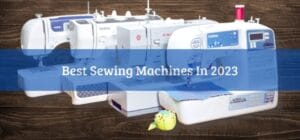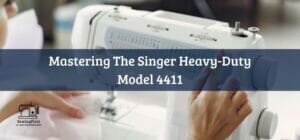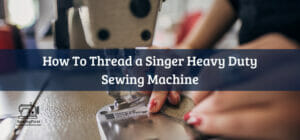Sewing machines are awesome. They make clothes, quilts, blankets, pillows, curtains, and even furniture. But they also require needles. Needles get lost, break, or just wear out over time.
When you lose a needle, you have two choices: buy another needle, or sew with a blunt needle. Both options suck.
But luckily, there’s a third option. In this guide, I’ll teach you how to replace sewing machine needles yourself. This will save you hundreds of dollars every year and allow you to enjoy your hobby again.
Related Topic: What Do the Colors on Sewing Machine Needles Mean: Uncovering a Mystery
Table of Contents
ToggleCauses of Sewing Machine Needle Replacement
Sewing machine needles need replacing every couple of years. The reason is simple – over time, sewing machine needles become dull and lose their sharpness. This causes them to break off easily, which means you’re out of luck until you replace them.

There are many reasons why sewing machine needles need replacement. One of the reasons is wear and tear. The presser foot wears down over time, which causes the needle to bend and break.
Another reason is clogging. Clogs occur when a thread becomes tangled inside the needle hole. This makes it impossible to insert the needle through the fabric.
Another common cause of sewing machine needle replacement is broken threads. Broken threads are usually caused by a loose bobbin case. Loose bobbins allow the thread to become entangled inside the bobbin case.
Whereas, some common causes of sewing machine replacement include:
- Overuse (overly frequent use)
- Improper maintenance
- Poor quality of materials used
- Faulty design
- The incorrect type of thread is being used
- Too long a stitch length
- Excessive tension
- Wrong needle position
- Stitch not pulling through properly
- Not enough fabric
- Fabric stretching
- Too short a stitch length
- Too tight a stitch width
- Too loose a stitch width
- Wrong needle type
What are the Solutions?
There are several solutions available to replace sewing machine needles. The most common solution is to purchase a set of replacement sewing machine needles. These sets include a variety of sizes and shapes, including straight, curved, and serrated. They’re usually sold at retail stores, online retailers, and through mail-order catalogs.
Another option is to purchase individual sewing machine needles. This method works well if you only need one type of needle. However, if you need multiple types of needles, then buying them individually may not work out very well.
If you decide to go with a set of sewing machine needles, you’ll need to determine which ones you need. There are three ways to do this:
- Buy a sewing machine needle guide. This tool helps you identify the right needle for your machine based on its brand, model number, and thread color.
- Use a sewing machine needle chart. This chart lists the various brands and models of sewing machine needles, along with their corresponding thread colors.
- Buy sewing machine needle kits. Kits contain everything you need to replace sewing machine needles. They include sewing machine needles, replacement tips, and a tool kit.
The most important factor in choosing sewing machine needles is the type of thread used. Choose a brand-name sewing machine needle that uses a strong cotton thread.
Avoid cheap brands that use polyester threads. Polyester threads break easily and may not hold up over time.
Sewing Machine Needle Replacement: How to Replace It? An easy-to-follow guide
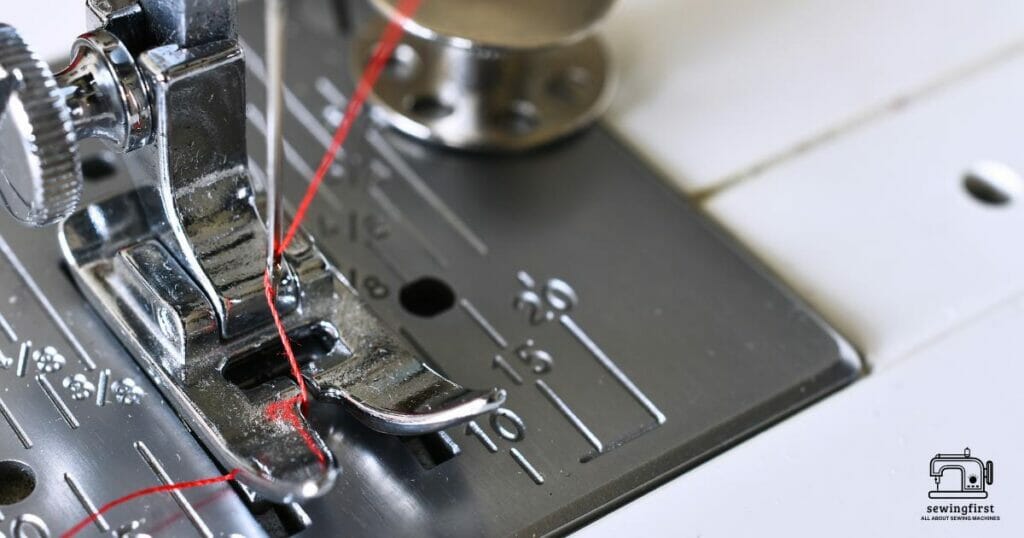
- Remove the cover from the sewing machine.
- Unplug the power cord.
- Disconnect the electrical connection between the motor and the control panel.
- Pull the top cover away from the base unit.
- Lift the presser foot assembly.
- Locate the needle plate.
- Slide the needle plate toward the front of the machine until it’s entirely removed.
- Remove the old needle.
- Insert the new needle into the hole where the old needle was located.
- Thread the new needle through the eye of the new spool.
- Secure the thread using a knot or a slip knot.
- Position the new needle to align with the hole in the needle plate.
- Lower the presser foot assembly back onto the bed.
Reattach the electrical connection between the base unit and the motor. Plug the power cord back into the wall socket and the machine on. Press the start button and Voila! Start stitching.
Important Thing: Needle Clamp and Needle Clamp Screw
Needles can be replaced without removing the needle clamp. Using a counterclockwise motion, loosen the needle clamp screw. Then lift off the needle clamp.
Next, slide the needle out of the needle slot. Finally, reinsert the needle into the needle slot. Reinstall the needle clamp and tighten the screw.
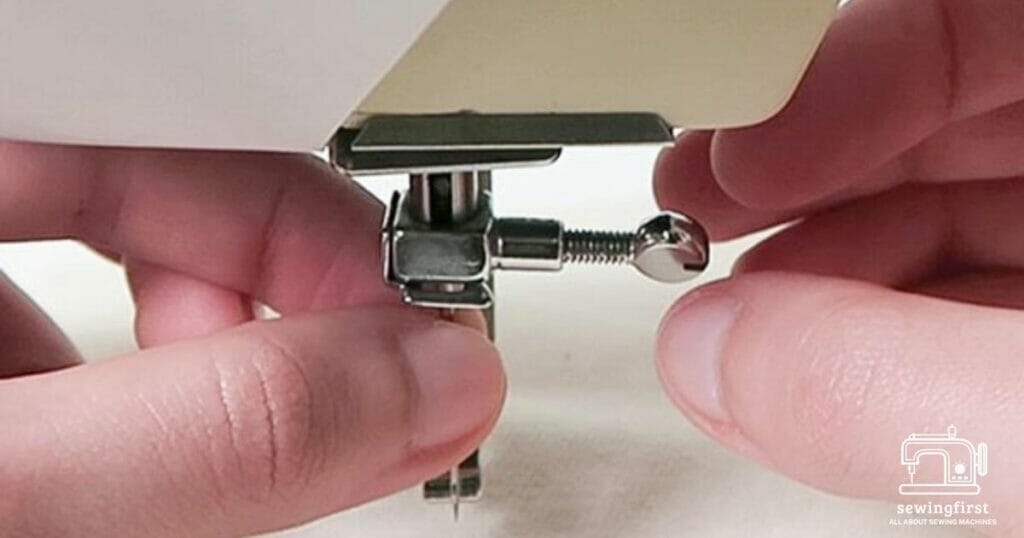
Needle stopper
A needle stopper prevents the needle from dropping down when the machine is turned off. It also keeps the needle from falling out of the needle slot while the machine is running.
Types Of Sewing Machine Needles
Sewing machine needles come in many different shapes and sizes. They’re used to sew fabric together, and they vary in length, thickness, and shape. Some are designed specifically for certain fabrics, while others work well with most materials.
There are two main types of sewing machine needles: universal and specialty. Universal needles are great for general-purpose sewing projects. They’re available in a variety of lengths and diameters (the diameter refers to the width of the needle).
Specialty needles are made for specific purposes. For example, embroidery needles are thinner than regular sewing machine needles, which makes them ideal for stitching delicate designs onto clothing.
Needle selection depends on the type of material you’re working with. For example, if you’re sewing leather, you should select a leather needle. Leather requires special care, so you need to avoid damaging the surface of the leather with a blunt needle.
If you’re sewing cotton, you should select a cotton needle. Cotton has a tendency to stretch out over time, so you need a needle that won’t break easily.
When selecting a needle, consider its length, thickness, and diameter. The longer the needle, the stronger it is. Thicker needles are better at holding stitches, while thicker needles hold more thread. Diameter refers to the width of a needle. Smaller needles are better for fine details, while larger needles are better for thick fabrics.
Choosing the Correct Needle for your Sewing Project
The first thing to do when choosing a sewing needle is to determine what kind of project you’re making. If you’re sewing a garment, choose a size appropriate for the fabric. If you’re sewing something like a pillowcase, choose a smaller needle.
It’s important to keep an eye on your sewing machine needles because they tend to wear out quickly. Broken needles cause holes in your fabric, which may lead to fraying or unraveling.
To prevent this problem, replace broken needles as soon as possible. You can find replacement needles online or at your local sewing store.
You’ll want to make sure you have enough spare needles to last
Next, look at the fabric you’ll be using. You can tell a lot about a fabric just by looking at it. A tightly woven fabric will require a finer needle than one that’s loosely woven.
Finally, consider how long you want your finished piece to last. Choose a needle that’s strong enough to withstand repeated use.
Sewing Machine Needle Sizes
You may have noticed that there are several different sizes of sewing machine needles. Each size represents a range of lengths and diameters. Here’s an overview of the most common sizes:
Universal Needles
These are the standard sewing machine needles. They’re available in various lengths and diameters.
Standard Length
Lengths from 1/2″ to 3″.
Diameters from.010″ to.020″.
Embroidery Needles
These needles are designed specifically for embroidery. They’re available in varying lengths and diameters. Embroidery needles are usually shorter than standard sewing machine needles.
Short Length
Lengths from 2″ to 4″.
Diameters from.018″ to.030″.
Long Length
Lengths from 5″ to 8″.
Diameters.030″ to.040″.
Cotton Needles
Cotton needs a very thin needle. These needles are available in varying lengths and thicknesses.
Thin Length
Lengths from 6″ to 10″.
Thickness from.015″ to.025″.
Medium Length
Lengths from 11″ to 14″.
Thickness from.025″ to.035″.
Heavy Length
Lengths from 15″ to 18″.
Thickness from.035″ to.045″.
Leather Needles
Leather needs a very sharp needle. These needles are only available as straight needles.
Straight Length
Lengths from 20″ to 24″.
Thickness.050″.
Needle Sets
A needle set includes both a top and bottom needle. Some sets include two sizes of each needle. Others include all four sizes.
Types of Fabric for Your Sewing Machine Needle
Fabric choice also plays an important role in determining the correct needle for your project. There are three main categories of fabric: natural fibers, synthetic fibers, and blended fabrics. Each category has its own characteristics, so you need to know what you’re working with before you make any decisions.
Natural Fiber Fabrics
Natural fiber fabrics include wool, silk, linen, and cotton. These fabrics have a soft feel and drape beautifully. However, they tend to shrink as they dry, so you may need to add additional layers to prevent this from happening.
Synthetic Fiber Fabrics
Synthetic fiber fabrics include polyester, nylon, acrylic, spandex, rayon, and modacrylic. These fabrics are durable and easy to care for. They don’t shrink or fray, but they lack the luster of natural fibers.
Blended Fiber Fabrics
Blended fabrics combine both natural and synthetic fibers. Blends come in many different varieties, including blends between cotton and synthetics, blends between wool and synthetics, and blends between cotton and wool.
You can find all kinds of fabrics at your local fabric store. When shopping for fabric, keep these tips in mind:
- Look for fabric that feels smooth against your skin. Smooth fabrics are easier to sew because they move smoothly through the machine.
- Avoid fabrics that have rough edges. This means avoiding anything made from coarse yarns, such as worsted-weight wool.
- Consider the amount of light your fabric needs. Lightweight fabrics are great for summer projects, while heavier fabrics work well during winter.
The sewing machine needle also depends on the thickness of the fabric. The thicker the fabric, the larger the hole in the fabric that will be left behind by the needle. If you choose a thick enough needle, it won’t leave much of a mark. But if you use too small of a needle, you’ll end up having to stitch over and over again to get the same result.
If you’re using a heavy-weight fabric, consider using a leather needle. Leather is a good choice for sewing heavy fabrics like leather, suede, and corduroy. It’s also a good choice for sewing denim jeans.
Conclusion
Sewing machines are an essential part of every household. They allow us to create beautiful clothing and accessories for ourselves and our loved ones.
However, sewing machine needles are prone to breakage. This means that sooner or later, you’ll need to replace your needle. Fortunately, replacing sewing machine needles isn’t hard. All you need to do is follow this guide.


